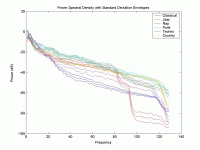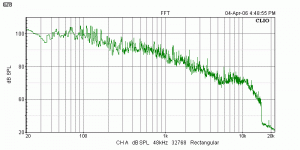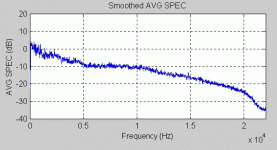thanx for explanation of BSC.BSC = Baffle Step Correction.
Passive crossovers do waste power. How much depends on their complexity and components used.
Once you start pricing up high quality inductors for the low pass(es) active operation quickly becomes very viable indeed financially.
Passives do however completely waste any control the amp may have had over the drivers otherwise. As a result an actively driven bass tends to stop quicker than one passively driven. At least to my ears.
I agree, that active is better, that's why I built one so many years ago.
and your argument that active bass sound better than passive is also very correct.
I never argued about those, just the efficiency of several poweramps of active compared to one of passive, and the way the article was claiming you get quadruple power by using two 100W amps in an active system.
You misread. he was showing how the PASSIVE case operates.I don't think I did!
1- in an active system the voltages would not be mixed, so the graph is wrong.
This has no effect on the main point, which is you get the same SPL with 100W dedicate bass amp in an active setup as you would with a 400W passive setup'2- we need to add the loudness of two or more drivers in an active system, not the voltages.
3- In practice (i.e. music) the system would start to clip (run out of power) in the bass amplifier first, hardly in mid or treble amplification eventhough they may have half the power capability of the previous amplifier.
[/QUOTE]
you get the same SPL with 100W dedicate bass amp in an active setup as you would with a 400W passive setup'
wrong!
I use 16 ohm 99dB (w/m) speakers, and my amps will only deliver 100W into that load- substantially less into the parts that are >16 (which is much of the bandwidth, it might be more accurate to call my system 20 ohms).
It's plenty, though I think about stepping down the impedance to allow the amp to throw more zoot at things- into 4 ohms I'd have 400WPC.
It's plenty, though I think about stepping down the impedance to allow the amp to throw more zoot at things- into 4 ohms I'd have 400WPC.
wrong!
Please correct me then. You chose the crossover points and the source music to get the spectral balance. Do the sums, see what the answers are.
Please correct me then.
Here is why:
in your example of an active system, only 100W is available for the all crucial bass region, not a watt more.
in your example of a passive system, disregarding for insertion loss of a passive crossover (amount debatable) all of the 400W is available for the same 'all crucial bass region'. (allowing for insertion loss 250-350W roughly)
Amps clip at bass frequencies far sooner than any other frequencies for a good reason, read up on 'music power spectrum' to see that in music (or audio), bass signals are about 20-30 times higher in level than mid frequencies, which themselves are at higher value compared to treble.
This is why you need a large diaphragm for a bass driver because it needs to move so much air, while a 1" dome tweeter can move enough air to match the loudness of a 12" bass driver.
It does not take a genius to see that you need more power at low frequencies compared to high.
Attachments
That's arm waving, not correction.
could be!
or you refuse or unable to comprehend.
And I'm baffled (no pun intended) by that graph, specifically the horizontal axis labeled "Frequency" and numbered from 0 to 140 in steps of 20. What's especially interesting is how all the plotted lines have their highest areas between 0 and 20 - does that mean for all those types of music that the highest volume level is BELOW 20 Hz?
ETA: I won't argue with "unable to comprehend."
ETA: I won't argue with "unable to comprehend."
ben - my thoughts exactly - perhaps citing the source / context of that graph would be enlightening?
Ken - as for low frequencies requiring more power / sensitivity than the higher octaves, no-one is disputing that - there's more than one way to skin a cat, and active amplification definitely has it's advantages.
back to the regularly scheduled pithing contest
Ken - as for low frequencies requiring more power / sensitivity than the higher octaves, no-one is disputing that - there's more than one way to skin a cat, and active amplification definitely has it's advantages.
back to the regularly scheduled pithing contest
Last edited:
Hi,
The equal power point for active is about 250Hz to 400Hz (programme dependent).
In theory : consider a 100W bass amplifier at full power at 100Hz along with
a mid/treble 100W amplifier at full power at 1KHz. You would need a 400W
amplifier to produce the same voltage swing. It of course would go louder
at 100Hz or 1KHz only, but audio amplifiers are not laboratory amplifiers.
rgds, sreten.
The equal power point for active is about 250Hz to 400Hz (programme dependent).
In theory : consider a 100W bass amplifier at full power at 100Hz along with
a mid/treble 100W amplifier at full power at 1KHz. You would need a 400W
amplifier to produce the same voltage swing. It of course would go louder
at 100Hz or 1KHz only, but audio amplifiers are not laboratory amplifiers.
rgds, sreten.
it is just a quick graph I pulled off the net, but it is valid.And I'm baffled (no pun intended) by that graph, specifically the horizontal axis labeled "Frequency" and numbered from 0 to 140 in steps of 20. What's especially interesting is how all the plotted lines have their highest areas between 0 and 20 - does that mean for all those types of music that the highest volume level is BELOW 20 Hz?
ETA: I won't argue with "unable to comprehend."
If you look closely, most types of music stop at 140, it is not hard to guess that means 14000 Hz.
equally 0 to 20 means 0 to 2000Hz.
Actually highest areas are from 0Hz to 200Hz.
Attachments
"pulled of the net" - as posted above, source and context could be illuminating
or not - a poorly lableled graph is more than slightly misleading
"most types of music stop at 140Hz" - really now, stop doing what exactly?
or not - a poorly lableled graph is more than slightly misleading
"most types of music stop at 140Hz" - really now, stop doing what exactly?
Last edited:
but music dependent you never have a situation in which you have 100W at 100Hz and 100W at mid/treble , such a sound is screamingly bright and unlistenable, with virtually no bass.Hi,
The equal power point for active is about 250Hz to 400Hz (programme dependent).
In theory : consider a 100W bass amplifier at full power at 100Hz along with
a mid/treble 100W amplifier at full power at 1KHz. You would need a 400W
amplifier to produce the same voltage swing. It of course would go louder
at 100Hz or 1KHz only, but audio amplifiers are not laboratory amplifiers.
rgds, sreten.
from the graph, if you need 100W at 100Hz, you only need a few watts for mid/treble.
would this do?"pulled of the net" - as posted above, source and context could be illuminating
or not - a poorly lableled graph is more than slightly misleading
"most types of music stop at 140Hz" - really now, stop doing what exactly?
it is from ESP - Frequency, Amplitude and dB
Also another plot from Chapter 4: Listening Tests
the other one was from OpenStax CNX
Attachments
Last edited:
I use 16 ohm 99dB (w/m) speakers, and my amps will only deliver 100W into that load- substantially less into the parts that are >16 (which is much of the bandwidth, it might be more accurate to call my system 20 ohms).
It's plenty, though I think about stepping down the impedance to allow the amp to throw more zoot at things- into 4 ohms I'd have 400WPC.
On the upside the greater speaker impedance keeps your amps in class a over a larger voltage swing! (Crossover distortion, etc)
Member
Joined 2009
Paid Member
I have observed the following, see how many you agree with: [...]
How many did I get right?
Looks like you got 'em all. I'm fifty something or other.
and I love and agree with your signature.Looks like you got 'em all. I'm fifty something or other.
but music dependent you never have a situation in which you have 100W
at bass and 100W at mid/treble , such a sound is screamingly bright and unlistenable, with virtually no bass.
Hi,
Your wrong. Mid/treble has much higher crest ratios than bass.
Average bass power is much higher than mid/treble power.
However you still need the same high peak capability as bass.
rgds, sreten.
so according to your assertion, all respectable active speaker manufacturers such as ATC and Meridian are in the wrong, since universally they have chosen much more powerful amplifiers for the bass compared to mid or high frequencies.Hi,
Your wrong. Mid/treble has much higher crest ratios than bass.
Average bass power is much higher than mid/treble power.
However you still need the same high peak capability as bass.
rgds, sreten.
Those idiots!
http://atcloudspeakers.co.uk/hi-fi/loudspeakers/hifi-entry-series/scm40a/
https://www.meridian-audio.com/prod...igital-active-loudspeaker/#post-specification
- Status
- Not open for further replies.
- Home
- Member Areas
- The Lounge
- League For High Efficiency Loudspeakers



